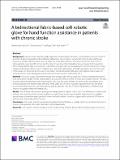A bidirectional fabric-based soft robotic glove for hand function assistance in patients with chronic stroke
Author(s)
Lim, Daniel Y.; Lai, Hwa-Sen; Yeow, Raye C.
Download12984_2023_Article_1250.pdf (2.634Mb)
Publisher with Creative Commons License
Publisher with Creative Commons License
Creative Commons Attribution
Terms of use
Metadata
Show full item recordAbstract
Abstract
Background
Chronic stroke patients usually experience reduced hand functions, impeding their ability to perform activities of daily living (ADLs) independently. Additionally, improvements in hand functions by physical therapy beyond six months after the initial onset of stroke are much slower than in the earlier months. As such, chronic stroke patients could benefit from an assistive device to enhance their hand functions, allowing them to perform ADLs independently daily. In recent years, soft robotics has provided a novel approach to assistive devices for motor impaired individuals, offering more compliant and lightweight alternatives to traditional robotic devices. The scope of this study is to demonstrate the viability of a fabric-based soft robotic (SR) glove with bidirectional actuators in assisting chronic stroke study participants with hand impairments in performing ADLs.
Methods
Force and torque measurement tests were conducted to characterize the SR Glove, and hand functional tasks were given to eight chronic stroke patients to assess the efficacy of the SR Glove as an assistive device. The tasks involved object manipulation tasks that simulate ADLs, and the series of tasks was done by the participants once without assistance for baseline data, and once while using the SR Glove. A usability questionnaire was also given to each participant after the tasks were done to gain insight into how the SR Glove impacts their confidence and reliance on support while performing ADLs.
Results
The SR Glove improved the participants’ manipulation of objects in ADL tasks. The difference in mean scores between the unassisted and assisted conditions was significant across all participants. Additionally, the usability questionnaire showed the participants felt more confident and less reliant on support while using the SR Glove to perform ADLs than without the SR Glove.
Conclusions
The results from this study demonstrated that the SR Glove is a viable option to assist hand function in chronic stroke patients who suffer from hand motor impairments.
Date issued
2023-09-21Department
Massachusetts Institute of Technology. Computer Science and Artificial Intelligence LaboratoryPublisher
BioMed Central
Citation
Journal of NeuroEngineering and Rehabilitation. 2023 Sep 21;20(1):120
Version: Final published version